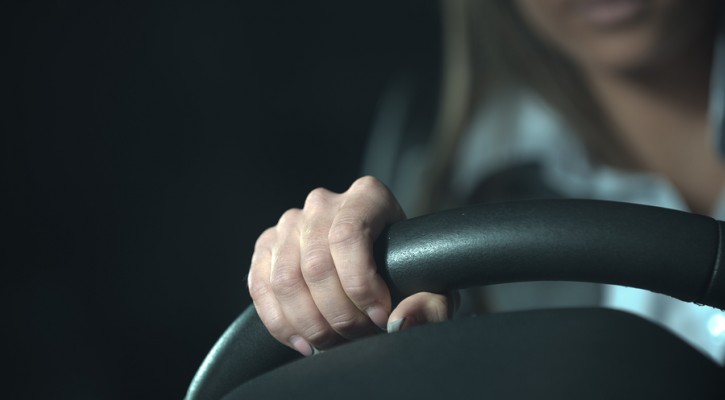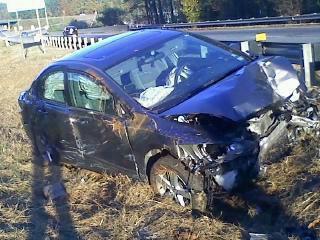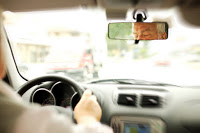Tag Archive: drowsy driving

Stiff Penalties For Nighttime Driving Leads To Fewer Teen Crashes
June 18, 2015
Stiffer penalties for violating nighttime driving restrictions can lead to fewer crashes by teen drivers according to a study published in the June 2015 edition of Health Affairs.
Teens lead busy lives and, especially during the school year, tend to not get enough sleep. The tendency to drive drowsy combined with limited visibility and limited driving experience make nighttime driving especially hazardous for teens.
It has long been recognized that the teen crash rate increases at night and most states restrict nighttime driving by teens as part of their Graduated Driver License Laws (GDL). Under the GDL laws, teens are normally restricted from driving without a licensed adult present generally from 11:00 pm until 6:00 am, depending on the state where they are licensed. Depending on the state, those restrictions are generally lifted either after the first year or when the teen reaches the age of 18.
The State of Massachusetts limits nighttime driving by teens between the hours of 12:30 am and 5:30 am. Prior to 2007, violation of this restriction resulted in a $35 fine for a first offense and fines of $75 to $100 for second and subsequent offenses. In 2007, Massachusetts changed the penalties for nighttime driving by teens to a 60 day, 180 day, and one year license suspension depending on the number of previous offenses.
The researchers from Brigham and Women’s Hospital (BWH) compared the crash rate for 16 and 17 year olds to the crash rate for older teens in the one year period prior to enactment of the new law and then compared those rates to crash rates during the first five years after enactment of the law.
The results showed that the rate of crashes involving fatal and incapacitating injury among drivers age 16-17 fell by 40 percent. The overall rate of police reported crashes for teens in the 16-17 age group fell by 19 percent and the nighttime crash rate fell by 29 percent.
According to the senior study author at BWH, “Our data demonstrate that the 2007 revisions to the Massachusetts Junior Operator Law have prevented about 320 fatal and incapacitating injuries and 13,000 motor vehicle crashes among Massachusetts teen drivers over the past eight years.
Read more: Stiffened penalties for nighttime teen driving associated with fewer fatal crashes

Planning For A Fun And Safe Spring Break
March 3, 2015
It’s that time of year again and the warm beaches of Florida are going to be prime destinations for spring breakers. Spring break is a lot of fun and can provide a lifetime of memories but it can also, just as easily, turn tragic. If you’re headed to the coast, remember the lessons learned in your drug and alcohol course as well as our top safety tips for a safe spring break.
- Maintain a buddy system – Travel with friends and stay with those friends to keep each other out of trouble. Along with college students, spring break also attracts unsavory types such as thieves and sexual predators. Don’t go off alone with someone you don’t know.
There are a lot of reasons not to drink but, if you feel you must:
- Have a plan – Plan on how you’ll get home safely, either by cab or a designated driver. Plan to limit your drinking. If you make a plan before you go out, chances are, you’ll stick with that plan but if you wait until after you’ve been drinking to decide what to do, your judgment will be clouded and you could drink yourself into trouble.
- Limit your drinking – While the effect of alcohol is different on everyone, a general rule of thumb is that it requires at least one hour for the body to process the alcohol from one drink. The more you drink, the longer it takes for the body to process the alcohol and get it out of your system. For females, who are generally smaller, one drink can affect you much more quickly than it will for a male and can take longer for the body to process.
- Binge drinking is deadly – Your body can only process so much alcohol before it becomes toxic. Alcohol affects your motor skills. You quickly start to feel the effect on the voluntary motor skills that control your speech, vision and ability to walk but too much alcohol can shut down the involuntary muscles controlling the heart and lungs and death from alcohol poisoning is the result. Drinking games look like fun but, for your own safety, make a plan before you go out not engage in any games that could lead to alcohol poisoning.
- Know what you’re drinking – Different drinks have different amounts of alcohol. Some sweet, flavorful cocktails can have up to four shots of liquor. Depending on your body size, a single cocktail can immediately put you over the legal limit.
- Females; guard your drinks – A female who leaves her drink unattended can easily become the victim of a sexual predator who has slipped Rohypnol (the date rape drug) into her drink. If you leave your drink unguarded at any time, dump it and get a fresh drink.
- Alcohol and the sun don’t mix – If you only drink alcoholic drinks when you’re out in the sun, you can easily become dehydrated. The combination of the sun and activities can quickly wear you out and alcohol will compound that effect. Switch off with water or fruit drinks.
- If it seems like a crazy stunt, it’s probably too dangerous – After drinking, spring breakers have died trying to show off by balancing on bannisters, doing pull ups off of hotel balconies, or trying to dive from a balcony into the hotel pool. Unfortunately, instead of stopping them, their friends, also under the influence of alcohol, urged them on. If you see someone trying to pull a dangerous stunt, try to stop them or call local security. You could save their life.
- Scooters and mopeds – If you rent a scooter or moped, make sure you’re familiar with its operation and watch out for other drivers on the road who may not be watching out for you. Never try to operate a scooter or moped if you’ve been drinking.
- Don’t party to the end – Don’t try to party up to the last second before leaving for home. If you’re driving, everyone in your party should try to get a good night’s sleep before heading home. Driving drowsy is just as dangerous as drunk driving.
- Stay alert driving on the road – Share driving duties and switch off with other drivers to remain alert. Long periods on a boring interstate can lead to “highway hypnosis”; avoid that by stopping every two hours or 100 miles to refresh yourself or take a short nap. If you have a long way to drive, don’t try to do it in a single trip. Stop and get some rest before continuing.
- DON’T DRIVE DRUNK OR DRUGGED!!!! – It should go without saying but there are far too many tragedies on spring break because people ignored this simple piece of advice!

Teen Drowsy Driving
December 8, 2014
Drowsy driving among teens is an issue that doesn’t get much notice when compared with all the other issues teen drivers face on the road but it’s a critical problem in the US. The following story is a typical example of the problem.
A 16 year old driver with less than 6 months solo experience behind-the-wheel set out, after school and cross country practice, with his 14 year old brother as a passenger to pick up their mother. Continue Reading

More Evidence Supports Later School Start Times
November 19, 2014
Another study has been published showing that later start times for high schools can reduce teen crashes. The study, conducted by the Eastern Virginia Medical School followed another, earlier study conducted in 2011 that looked at teen crash rates in two Virginia school districts with different high school start times.
The latest study looked at teen crash rates in Virginia’s Chesterfield and Henrico counties. After determining that there were no discernible differences in the adult crash rate between the two counties, the researchers compared the teen crash rates for the two counties. The researchers found that the crash rate for teens in Chesterfield county where school begins at 7:20 AM was significantly higher than the teen crash rate in Henrico county where school begins almost one and a half hours later at 8:45.
These findings agree with earlier, similar studies that led the American Academy of Pediatrics to issue a policy statement last August calling on school districts across the nation to adjust their high school start times no earlier than 8:30. According to the Academy statement, teen sleep rhythms naturally shift and it’s nearly impossible for teens to get to sleep earlier than 10:30 PM. Developing teens also need more sleep than adults. When schools start too early, it’s impossible for teens to get the needed amount of sleep leaving them fatigued and at risk when they drive. Other studies also point to a correlation between later start times and higher standardized test scores for teens.
All of the research points in the same direction. Later school start times for teens can save lives. School boards and administrators in districts where school starts earlier than 8:30 AM need to be made aware of this data and should be urged to move the start times to later in the morning.
For more information, read: Research reinforces link between increase in teen driver crashes and early high school start times

Remember the Time Change Can Affect Your Driving
November 2, 2011
It’s that time of the year again; time to fall back and set the clocks to Standard Time. The time change can cause disruptions while our mind and body adapt to the new time and that disruption can extend to our driving.
Changing back from Daylight Savings Time to Standard Time occurs on the first Sunday in November and that falls on November 6th this year. The time change officially happens at 2:00 AM on Sunday November 6th. Falling back means setting the clock back one hour; at 2:00 AM set your clocks back to 1:00 AM. The great thing about falling back is that we all get an extra hour of sleep on Saturday night. Those who don’t get the word will probably arrive at church an hour early and wonder where everyone is or why that football game hasn’t started yet.
The time change is always somewhat confusing because it takes our minds a few days to adapt to the new change. Those of you who are used to waking up and beginning your morning commute in the dark will be waking up to the sunrise. Those who enjoy the extra sunlight after work will be getting home in the dark.
The time change in the fall isn’t as disruptive as the spring time change. In spring we lose an hour of sleep and sleep experts say that losing even one hour of sleep can have an impact on our driving and driving while drowsy is just as dangerous as driving under the influence. However, even though we aren’t going to lose any sleep, our driving can still be affected because of the time it takes our internal clock to adjust to the change.
Our internal biological clock or circadian rhythm regulates our wake sleep cycle. It was easy before clocks were invented; we woke up at dawn and we went to sleep when it got dark. Sleep experts also say it is natural for us to become sleepy in the late afternoon. In the modern world, our days are regulated by the clock and that mechanical clock can sometimes come into conflict with our biological clock. Some sleep experts suggest that we follow the example of Mediterranean cultures and allow employees to nap in the afternoon in order to gain maximum performance. When we force ourselves to remain awake through that natural afternoon drowsy time, it can lead to drowsiness behind the wheel on the long commute home. One survey of drivers found that more than one-third (35%) of drivers who nodded off while driving within the previous six months say their last experience occurred between 6:00 a.m. and 5:00 p.m. An additional 17% report they nodded off between 5:00 p.m. and 9:00 p.m.
A study using mice (that also has implications for humans) found that when circadian rhythm cycles were disrupted, the mice didn’t perform as well in maze tests as the control group whose circadian patterns weren’t disrupted. They also exhibited impulsive behavior which, for human drivers, can mean trying to beat that light or pulling out in front of another car. When darkness suddenly falls an hour earlier, drivers may find themselves driving a little faster; trying to get home before daylight fades.
Another problem occurs because light conditions at dusk – before total darkness – can be confusing. Shapes that show up clearly in daylight or in a car’s headlights may not show up as clearly at dusk. A study conducted in 1995 found that the number of auto/pedestrian crashes increased substantially in the period following the time change back to standard time. Kids are still walking home from practice or trying to get in a little extra playing time with their neighborhood pals before total darkness. A University of California trauma center found a “62 percent increase in the number of children in auto-vs-pedestrian crashes and auto-vs.-bicycle crashes in the two weeks following the October time change. Of these victims, 90 percent had severe injuries and required surgery.”
Until their body clock adjusts to the new time, drivers should be especially cautious during the first few weeks after the time change. Get plenty of sleep, don’t give in to the impulse to rush home to beat the sunset, and be especially watchful for pedestrians.
Drowsy driving prevention week is Nov.6 – 12. For more information on sleep and sleep disorders, visit the National Sleep Foundation’s web site at: http://www.sleepfoundation.org/
